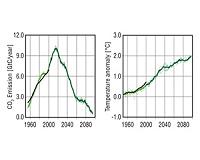| . |  |
. |
Moffett Field CA (SPX) Aug 05, 2010 Climate change scenarios are usually summed up in terms of expected change by a certain year. Like sea levels will rise by x amount by 2020 and y amount by 2050. Or by parts per million of CO2 in the atmosphere. But because no one really knows what kind of carbon dioxide increases we're facing (that having to do with the CO2 cutting regimen we choose), the whole forecasting effort becomes very ambiguous. That's led some to throw their hands up on achieving greenhouse gas reductions in favor of adaptation planning. A new report issued by the U.S. National Research Council takes a different approach. It orients climate change scenarios to degree increase in temperature to show what each degree gets you in impact. "An important reason for using warming as a reference is that scientific research suggests that many key impacts can be quantified for given temperature increases," the report states. It's a very nuts and bolts approach, allowing for people to see clearly the consequences of each degree of warming and determine what is the acceptable level of risk. For members of Congress debating a climate change bill, the report provides a handy reference point for making decisions that will impact the Earth for centuries or longer. Let's look at food production. Depending on the species and other factors like rainfall, many crops respond well to a 1-2 degree C temperature increase. Anything higher and things start to look dicey. Asian rice fairs comparatively well, but U.S. and African maize, Indians wheat, and U.S. soybean crops show a sharp drop-off in yield. U.S. maize will see a stunning 11 percent drop in yield per degree C of warming. That doesn't sound good. Not only does that feed Americans, but about 40 percent is currently exported to fill bellies in the rest of the world. One degree C warming also increases wildfires in the western U.S. by 200-400 percent, depending on location and available fuel. It was also reduce rainfall in the American Southwest, Mediterranean, and southern Africa by 5 -10 percent. Under a 2 degree C temperature increase, the southwest and central part of the U.S. would see three times the number of high heat days, exceeding 38 degree C or 100 degree F. You get the picture. Climate change skeptics often minimize the impact of a couple degrees increase. Who doesn't like warmer weather? But put in concrete terms, we may one day miss the comfort of a cold winter day by the fire. Or in California, a bleak, foggy day spent in a cafe.
Warm as the Arctic The glaciers in this Canadian outpost have been rapidly disintegrating; its main Ward Hunt Ice shelf fractured a couple years ago, while another, the Markham shelf, broke off into the sea. It's a great place to study the effects of climate change, both modern and past. Beaver Pond on Ellesmere Island is exceptionally well preserved with peat layers that contain a diverse assemblage of 4 to 5 million year old fossils from a time when the Earth was much warmer than today, and Beaver Pond teeming with life. Researchers led by the University of Colorado and Canadian Museum of Nature have studied some of these fossils to get a more precise estimate of the Arctic temperature during that time period. It was, of course, warmer than today's Arctic. But what's surprising is that the Arctic temperature was considerably warmer relative to today than global averages. In a paper they published in the most recent journal of Geology, the found that while the average global temperature during the Pliocene was 3.6 to 5.4 degrees Fahrenheit warmer than today, Arctic temperatures may have been a whopping 34 degrees balmier. "These results indicate that Arctic temperatures may be exceedingly sensitive to anthropogenic CO2 emissions," the researchers write. Essentially, tropical temperatures varied a lot less than what was happening in the Arctic. This "reduced temperature gradient" can be explained by a number of mechanisms. Heat transport northward from ocean circulation is one potential warming factor, as are changes in Arctic cloud cover and greater absorption of heat due to less ice and darker waters.
What does this spell for today's Arctic?
Share This Article With Planet Earth
Related Links Hot Zone blog entry Climate Science News - Modeling, Mitigation Adaptation
 New Carbon Dioxide Emissions Model
New Carbon Dioxide Emissions ModelHamburg, Germany (SPX) Aug 05, 2010 The Intergovernmental Panel on Climate Change (IPCC) calculated projected temperature changes for various scenarios in 2007 and researchers at the Max Planck Institute for Meteorology in Hamburg have now gone one step further: they have developed a new model that specifies the maximum volumes of carbon dioxide that humans may emit to remain below the critical threshold for climate warming of two ... read more |
|
| The content herein, unless otherwise known to be public domain, are Copyright 1995-2010 - SpaceDaily. AFP and UPI Wire Stories are copyright Agence France-Presse and United Press International. ESA Portal Reports are copyright European Space Agency. All NASA sourced material is public domain. Additional copyrights may apply in whole or part to other bona fide parties. Advertising does not imply endorsement,agreement or approval of any opinions, statements or information provided by SpaceDaily on any Web page published or hosted by SpaceDaily. Privacy Statement |